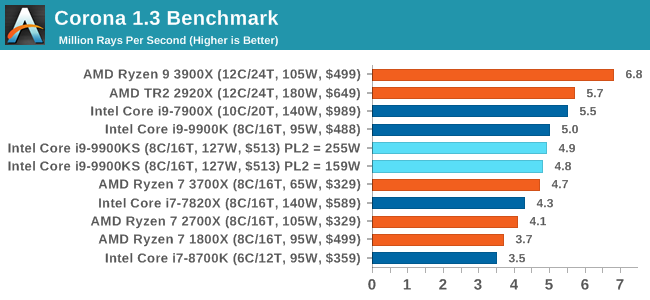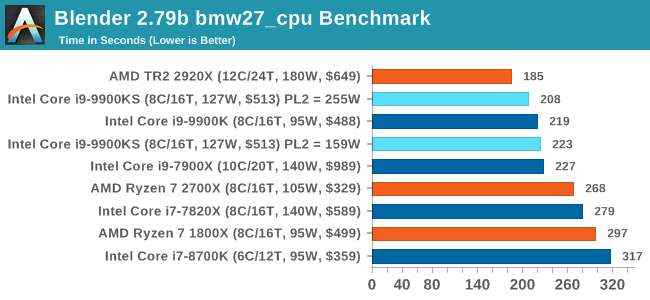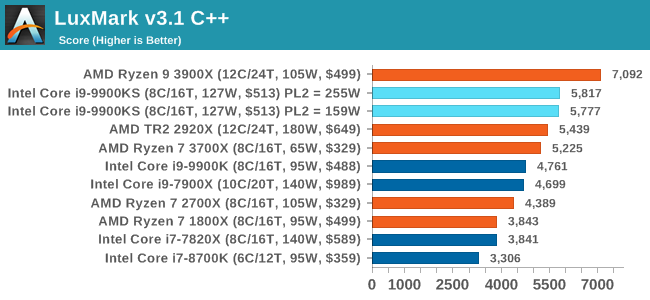The Intel Core i9-9900KS Review: The 5 GHz Consumer Special
by Dr. Ian Cutress on October 31, 2019 10:45 AM ESTCPU Performance: Rendering Tests
Rendering is often a key target for processor workloads, lending itself to a professional environment. It comes in different formats as well, from 3D rendering through rasterization, such as games, or by ray tracing, and invokes the ability of the software to manage meshes, textures, collisions, aliasing, physics (in animations), and discarding unnecessary work. Most renderers offer CPU code paths, while a few use GPUs and select environments use FPGAs or dedicated ASICs. For big studios however, CPUs are still the hardware of choice.
All of our benchmark results can also be found in our benchmark engine, Bench.
Corona 1.3: Performance Render
An advanced performance based renderer for software such as 3ds Max and Cinema 4D, the Corona benchmark renders a generated scene as a standard under its 1.3 software version. Normally the GUI implementation of the benchmark shows the scene being built, and allows the user to upload the result as a ‘time to complete’.
We got in contact with the developer who gave us a command line version of the benchmark that does a direct output of results. Rather than reporting time, we report the average number of rays per second across six runs, as the performance scaling of a result per unit time is typically visually easier to understand.
The Corona benchmark website can be found at https://corona-renderer.com/benchmark

Interestingly both 9900KS settings performed slightly worse than the 9900K here, which you wouldn't expect given the all-core turbo being higher. It would appear that there is something else the bottleneck in this test.
Blender 2.79b: 3D Creation Suite
A high profile rendering tool, Blender is open-source allowing for massive amounts of configurability, and is used by a number of high-profile animation studios worldwide. The organization recently released a Blender benchmark package, a couple of weeks after we had narrowed our Blender test for our new suite, however their test can take over an hour. For our results, we run one of the sub-tests in that suite through the command line - a standard ‘bmw27’ scene in CPU only mode, and measure the time to complete the render.
Blender can be downloaded at https://www.blender.org/download/

All the 9900 parts and settings perform roughly the same with one another, however the PL2 255W setting on the 9900KS does allow it to get a small ~5% advantage over the standard 9900K.
LuxMark v3.1: LuxRender via Different Code Paths
As stated at the top, there are many different ways to process rendering data: CPU, GPU, Accelerator, and others. On top of that, there are many frameworks and APIs in which to program, depending on how the software will be used. LuxMark, a benchmark developed using the LuxRender engine, offers several different scenes and APIs.
In our test, we run the simple ‘Ball’ scene on both the C++ and OpenCL code paths, but in CPU mode. This scene starts with a rough render and slowly improves the quality over two minutes, giving a final result in what is essentially an average ‘kilorays per second’.

Both 9900KS settings perform equally well here, and a sizeable jump over the standard 9900K.
POV-Ray 3.7.1: Ray Tracing
The Persistence of Vision ray tracing engine is another well-known benchmarking tool, which was in a state of relative hibernation until AMD released its Zen processors, to which suddenly both Intel and AMD were submitting code to the main branch of the open source project. For our test, we use the built-in benchmark for all-cores, called from the command line.
POV-Ray can be downloaded from http://www.povray.org/

One of the biggest differences between the two power settings is in POV-Ray, with a marked frequency difference. In fact, the 159W setting on the 9900KS puts it below our standard settings for the 9900K, which likely had an big default turbo budget on the board it was on at the time.











235 Comments
View All Comments
Supercell99 - Thursday, October 31, 2019 - link
Yea you are not going to be able to OC a 9900K much. They have panned through all the 9900 goldJorgp2 - Thursday, October 31, 2019 - link
This is a new stepping.TEAMSWITCHER - Thursday, October 31, 2019 - link
The time to hop on the 9900K train was at the introduction.. Now just wait for Comet Lake.AshlayW - Friday, November 1, 2019 - link
Or be a smart consumer and wait for 3900X to be back in stock :)Sivar - Friday, November 1, 2019 - link
Most PC users make better use of fast cores than more cores.GreenReaper - Friday, November 1, 2019 - link
Historically this has been very true. However browsers nowadays can take advantage of many cores, as can games - they have been forced to, or else be outcompeted by those who do.Kjella - Thursday, October 31, 2019 - link
Considering it's a brief holiday special I would think this is all the golden samples from the past year. I'm quite sure they all pre-bin and keep chips that are "perfect" in some way like no defects/high frequency/ultra low voltage even though they don't have an SKU for it yet. Normally they'd launch one notch up as a 9950K or something, with this time limited special I guess Intel is saying we'll never produce these chips in enough volume to justify that so we're doing a limited edition for PR instead.Spunjji - Friday, November 1, 2019 - link
Nailed it.GreenReaper - Saturday, November 2, 2019 - link
They keep the duds, too. That's one reason the Pentium and Celeron come out later. The other being they don't want to spoil the market for higher-end chips.DigitalFreak - Thursday, October 31, 2019 - link
Once you cut through all the Intel marketing BS, to run all cores at 5Ghz as advertised it's a 172W processor.